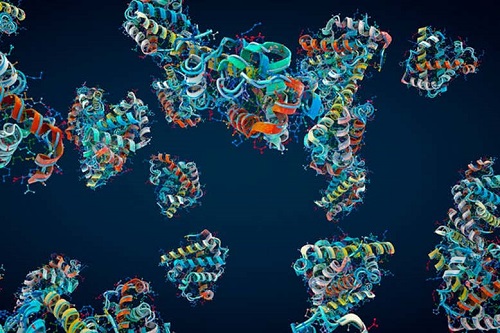
Proteins are made up of chains of amino acids. Image source: New Scientist magazine website
American scientists published a paper in the latest issue of "Nature Biotechnology" magazine stating that they have developed a new artificial intelligence (AI) tool ProGen, which can design antibacterial proteins from scratch that have been proven to be effective. The latest method is promising Used to develop new drugs.
Proteins are made up of chains of amino acids, and the order of these amino acids determines the protein's shape and function. In the latest study, researchers at California biotech startup Profiloent used AI to design millions of new proteins and then selected some of them to make small samples to test whether they worked.
The researchers noted that ProGen works similarly to an AI that generates text. ProGen learned how to generate new proteins by learning how amino acids combine to form the 280 million existing proteins. Furthermore, researchers can focus ProGen on designing a certain group of similar proteins, such as those with antimicrobial activity.
The scientists checked the AI's design process so that it didn't let the amino acids "babble". They also tested the AI-designed molecular samples in real cells. The results showed that of the 100 molecules they created based on the AI design, 66 participated in chemical reactions similar to natural proteins, destroying bacteria in egg whites and saliva, suggesting that these new proteins can kill bacteria. The researchers then selected the five most reactive proteins and added them to the E. coli samples. Two of the proteins destroyed the bacteria.
Next, the researchers imaged the proteins with X-rays, which showed that although the proteins' amino acid sequences differed by up to 30 percent from any existing protein, their shapes were almost similar to those of native proteins. Researchers say a similar process could be used to develop new molecules for testing in drugs.
As organic macromolecules, proteins are an important material basis of life and are undoubtedly an important research object in life sciences. With the continuous penetration of artificial intelligence technology in the field of life sciences, protein-related research has become the forefront of artificial intelligence "testing the waters": from "alpha folding" that can accurately predict the static three-dimensional structure of proteins to the first attempt to analyze the dynamic conformation of proteins From artificial intelligence methods to the ability to design new proteins from scratch or even focus on designing a group of similar proteins, the field of protein research is witnessing rapid iterative upgrades in artificial intelligence applications.
Previous article:Million-fold acceleration: Accelerated computing helps gene sequencing break through the limits
Next article:Chinese scientists use artificial intelligence to detect blinding eye diseases in infants and young children
Recommended ReadingLatest update time:2024-11-16 14:50



- Popular Resources
- Popular amplifiers
- High-speed 3D bioprinter is available, using sound waves to accurately build cell structures in seconds
- [“Source” Observation Series] Application of Keithley in Particle Beam Detection Based on Perovskite System
- STMicroelectronics’ Biosensing Innovation Enables Next-Generation Wearable Personal Healthcare and Fitness Devices
- China's first national standard for organ chips is officially released, led by the Medical Devices Institute of Southeast University
- The world's first non-electric touchpad is launched: it can sense contact force, area and position even without electricity
- Artificial intelligence designs thousands of new DNA switches to precisely control gene expression
- Mouser Electronics provides electronic design engineers with advanced medical technology resources and products
- Qualcomm Wireless Care provides mobile terminal devices to empower grassroots medical workers with technology
- Magnetoelectric nanodiscs stimulate deep brain noninvasively
- Innolux's intelligent steer-by-wire solution makes cars smarter and safer
- 8051 MCU - Parity Check
- How to efficiently balance the sensitivity of tactile sensing interfaces
- What should I do if the servo motor shakes? What causes the servo motor to shake quickly?
- 【Brushless Motor】Analysis of three-phase BLDC motor and sharing of two popular development boards
- Midea Industrial Technology's subsidiaries Clou Electronics and Hekang New Energy jointly appeared at the Munich Battery Energy Storage Exhibition and Solar Energy Exhibition
- Guoxin Sichen | Application of ferroelectric memory PB85RS2MC in power battery management, with a capacity of 2M
- Analysis of common faults of frequency converter
- In a head-on competition with Qualcomm, what kind of cockpit products has Intel come up with?
- Dalian Rongke's all-vanadium liquid flow battery energy storage equipment industrialization project has entered the sprint stage before production
- Allegro MicroSystems Introduces Advanced Magnetic and Inductive Position Sensing Solutions at Electronica 2024
- Car key in the left hand, liveness detection radar in the right hand, UWB is imperative for cars!
- After a decade of rapid development, domestic CIS has entered the market
- Aegis Dagger Battery + Thor EM-i Super Hybrid, Geely New Energy has thrown out two "king bombs"
- A brief discussion on functional safety - fault, error, and failure
- In the smart car 2.0 cycle, these core industry chains are facing major opportunities!
- The United States and Japan are developing new batteries. CATL faces challenges? How should China's new energy battery industry respond?
- Murata launches high-precision 6-axis inertial sensor for automobiles
- Ford patents pre-charge alarm to help save costs and respond to emergencies
- New real-time microcontroller system from Texas Instruments enables smarter processing in automotive and industrial applications

 Introduction to Internet of Things Engineering 2nd Edition (Gongyi Wu)
Introduction to Internet of Things Engineering 2nd Edition (Gongyi Wu)
















 京公网安备 11010802033920号
京公网安备 11010802033920号